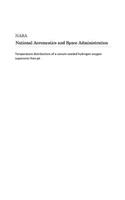
Temperature Distributions of a Cesium-Seeded Hydrogen-Oxygen Supersonic Free Jet
Series:
The hydrogen-oxygen plasma was generated at combustion chamber pressures ranging from 0.5 to 2.0 megapascals and for various seed ratios (1 to 10 percent). The plasma was observed as the atmospheric exhaust from a Mach 2 rocket test facility. Transverse profiles of the absolute integrated intensity were measured with the optically thin CsI lines (0.5664 and 0.5636 microns) at a range of axial posi
NaN
VOLUME
English
Paperback

The hydrogen-oxygen plasma was generated at combustion chamber pressures ranging from 0.5 to 2.0 megapascals and for various seed ratios (1 to 10 percent). The plasma was observed as the atmospheric exhaust from a Mach 2 rocket test facility. Transverse profiles of the absolute integrated intensity were measured with the optically thin CsI lines (0.5664 and 0.5636 microns) at a range of axial positions downstream of the 5-cm-diameter combustor nozzle exit. Radial profiles of the emission coefficient were obtained from the measured transverse profiles of intensity by Abel inversion. Temperatures were then determined from the emission coefficients for conditions of local thermodynamic equilibrium using particle densities generated by a two-dimensional free jet computer program. Temperature results show the inherent effects of compression and expansion pressure waves characteristic of a free jet exiting from a supersonic nozzle. Wang, S. Y. and Smith, J. M. Glenn Research Center NASA-TP-1162, E-9267 RTOP 506-25
Price Comparison [India]
In This Series
Bestseller Manga
Trending NEWS




















